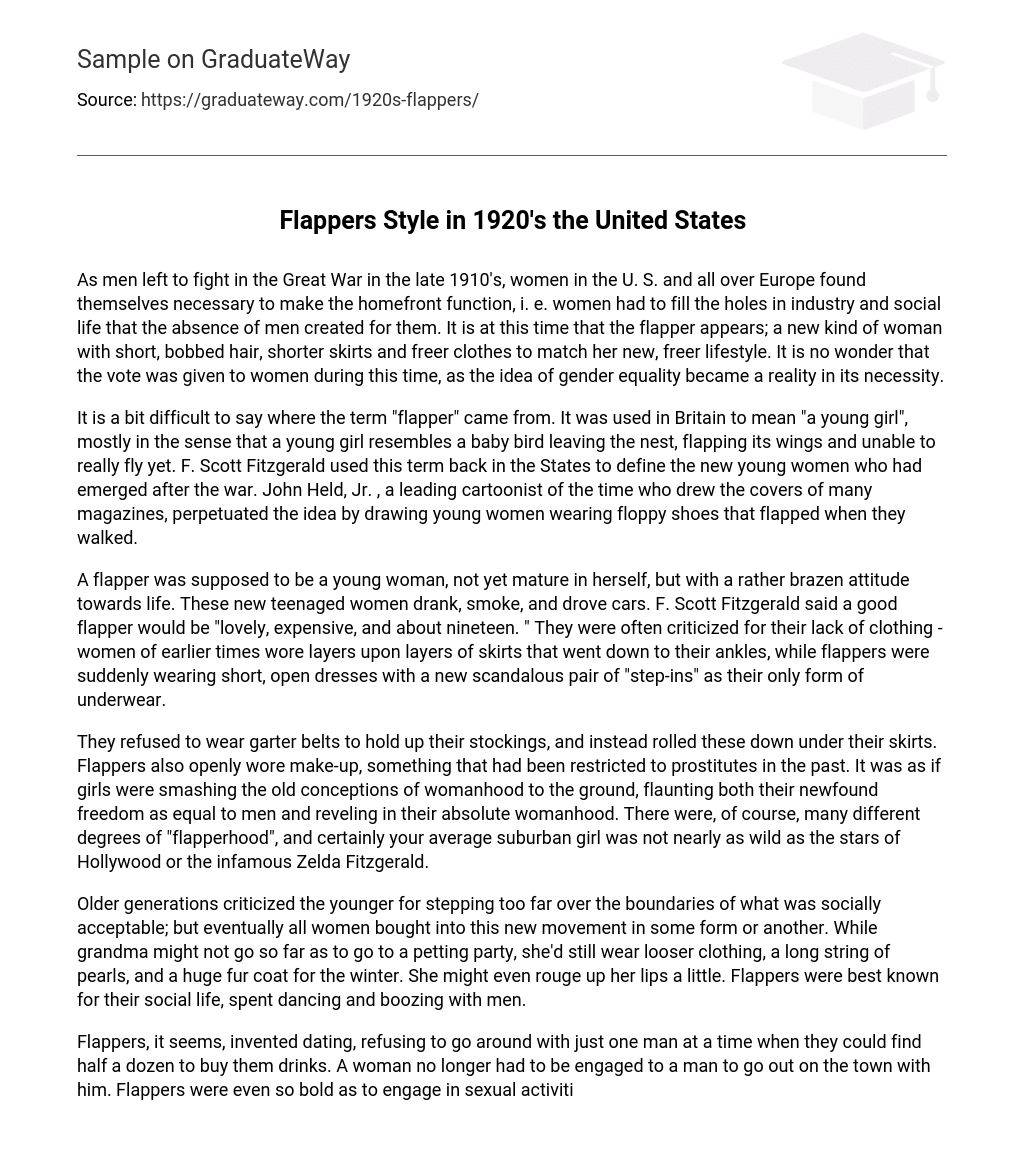During the late 1910’s, women in the U.S. and Europe had to take on important roles during the Great War while men were away. They had to fill in for men in industry and social life. This period saw the emergence of a new type of woman called the flapper. Flappers wore short haircuts, shorter skirts, and embraced a more liberated lifestyle. It is not surprising that women gained voting rights during this time as gender equality became necessary.
The origin of the term “flapper” is somewhat challenging to determine. In Britain, it was used to describe a young girl, emphasizing their similarity to fledgling birds flapping their wings without being able to fly. F. Scott Fitzgerald adopted this term in the United States to characterize the newly emerged young women after the war. Further popularizing the concept was John Held, Jr., an influential cartoonist, who depicted these young women wearing loose-fitting shoes that made a flapping sound when walking.
A flapper was a youthful woman who displayed a fearless and daring outlook on life, although she had not yet attained full maturity. These adolescent ladies frequently partook in activities such as drinking, smoking, and driving automobiles. F. Scott Fitzgerald claimed that an ideal flapper should possess the qualities of being “lovely, expensive, and approximately nineteen years old.” They faced criticism for their choice of revealing clothing. In contrast to the previous generation, who wore multiple layers of ankle-length skirts, flappers adopted a scandalous fashion style characterized by short, open dresses. Furthermore, they shocked society with their innovative type of undergarments called “step-ins.”
They rejected the use of garter belts for stocking support and opted to roll them down under their skirts instead. Flappers also boldly applied make-up, a practice previously associated with prostitutes. It seemed that girls were defying traditional notions of femininity, proudly showcasing their newfound equality with men while embracing their femininity. It should be noted that there were varying levels of “flapperhood”, and the typical suburban girl was not as daring as the Hollywood stars or the notorious Zelda Fitzgerald.
Older generations criticized the younger for pushing the boundaries of social acceptability. However, eventually, all women embraced this new movement to some extent. Even though grandma wouldn’t attend petting parties, she would still dress in looser clothing, wear a long string of pearls, and don a large fur coat in the winter. She might even apply a bit of rouge to her lips. Flappers were primarily recognized for their active social lives, which involved dancing and drinking with men.
Flappers, it appears, were the pioneers of dating, rejecting the idea of being exclusive with one man when they could have multiple suitors buying them drinks. It was no longer necessary for a woman to be engaged to go out with a man. Flappers went even further by engaging in premarital sexual activities with men. Petting parties were prevalent, and girls who partook in these casual sexual encounters were not shunned or stigmatized as promiscuous.
Although women in the past maintained their virginity until marriage, it is important to note that they engaged in affectionate actions such as hugging and kissing with different partners publicly. It is worth considering how society reacted to these behaviors, as such activities were typically restricted to married couples within the confines of their homes. Furthermore, these women were recognized for their unique language, which involved creating terms to describe various aspects of their modern lifestyle. These included terms for individuals who were stingy, boring, intoxicated, or exhibited promiscuous behavior – all of which were encountered by flappers during this time.
For example, a young man who attended petting parties was called a “snugglepup.” Feet were referred to as “dogs,” and shoes were called “kennels.” Additionally, an engagement ring was symbolized by the term “handcuff.” This vibrant and descriptive new slang was difficult for parents and adults to understand, making it an effective code. The flapper lifestyle was idolized by notable women like Zelda Fitzgerald, Anita Loos, as well as numerous actresses in both film and theater.
The style quickly spread and ignited the 1920s with a new energy and excitement that was unprecedented in the urbanized society of the United States at that time. Regrettably, the prosperity couldn’t endure indefinitely; in 1929, along with the stock market crash, hemlines lowered as the economy declined, and carefree lifestyles became impossible to sustain. Nevertheless, the flapper will forever be remembered as one of the most vibrant personalities in American history, and her fashion will continue to be mimicked in this nation as long as there are young women seeking enjoyment.





